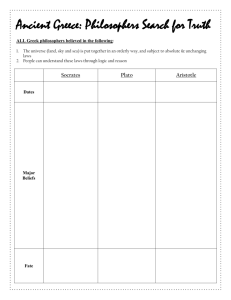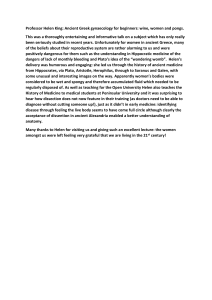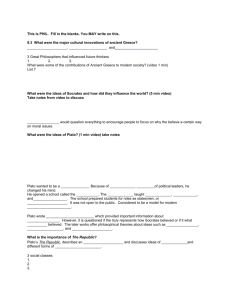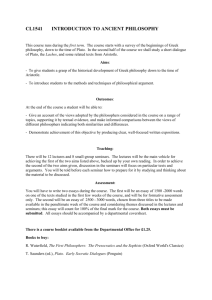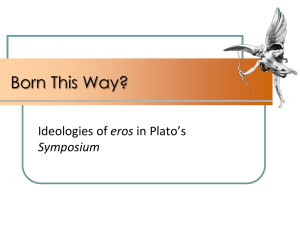Chapter 1 Introduction to Science Technology and Society
advertisement
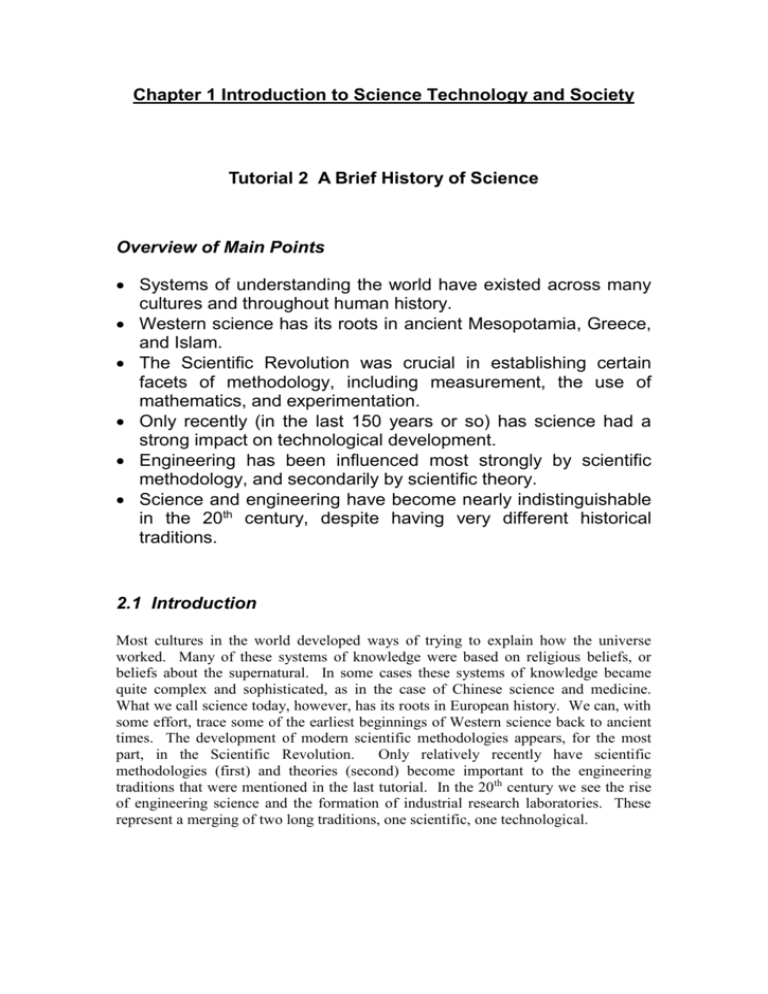
Chapter 1 Introduction to Science Technology and Society Tutorial 2 A Brief History of Science Overview of Main Points Systems of understanding the world have existed across many cultures and throughout human history. Western science has its roots in ancient Mesopotamia, Greece, and Islam. The Scientific Revolution was crucial in establishing certain facets of methodology, including measurement, the use of mathematics, and experimentation. Only recently (in the last 150 years or so) has science had a strong impact on technological development. Engineering has been influenced most strongly by scientific methodology, and secondarily by scientific theory. Science and engineering have become nearly indistinguishable in the 20th century, despite having very different historical traditions. 2.1 Introduction Most cultures in the world developed ways of trying to explain how the universe worked. Many of these systems of knowledge were based on religious beliefs, or beliefs about the supernatural. In some cases these systems of knowledge became quite complex and sophisticated, as in the case of Chinese science and medicine. What we call science today, however, has its roots in European history. We can, with some effort, trace some of the earliest beginnings of Western science back to ancient times. The development of modern scientific methodologies appears, for the most part, in the Scientific Revolution. Only relatively recently have scientific methodologies (first) and theories (second) become important to the engineering traditions that were mentioned in the last tutorial. In the 20th century we see the rise of engineering science and the formation of industrial research laboratories. These represent a merging of two long traditions, one scientific, one technological. 2.2 Ancient and Medieval Science In 3,000 BC, the Egyptians were using decimal numbers and elementary geometry. In 2,000 BC the Babylonians (modern day Iraq) used a sexagesimal system. And by 500 BC the Babylonians had a very advanced astronomical system that was able to predict with great accuracy. Ancient Greece was also important for the development of science, as philosophers began considering naturalistic (versus supernatural) explanations of the world. They imagined an ordered world, or Kosmos. Plato (427-348) was a philosopher who argued that a divine craftsman constructed the Kosmos according to geometry. All elements could be reduced to triangular shapes. Plato wrote the Timaeus, which gives an account of the structure of the Kosmos. Plato and Eudoxus developed the 2 sphere model of the universe. It was a geometric representation of the Kosmos. All motion, even irregular, was a series of compound regular geometric patterns. Aristotle (384-322) was a student of Plato’s. He did a great amount of biological research. Along with Plato, his natural philosophy was deeply influential. Euclid (~300 B.C.) wrote a geometry textbook, Elements. Geometrical proof followed from definitions, postulates, and axioms. Archimedes (287-212) developed a science of weights. Analyzed the equilibrium of planes (levers). The ancient Romans studied Greek scholarship, but did not add much to it. Intellectual pursuits in the Western Roman Empire declined as it was invaded in the 4th and 5th centuries. Science did not flourish in the Eastern Roman Empire (Byzantine Empire) either. Science did flourish in Islamic societies. Islam begins with the birth of Mohammed in the 6th century A.D. The religion quickly spread within a few decades across North Africa. Greek science was translated into Arabic. From the 9th century to the 13th century, Islamic science prospered, and added significantly to astronomy, optics, and medicine. Islamic science declined in the 14th century due to the rise of Europeans in the west, and Mongol invasions in the east. In the meantime, the Europeans had been building a large university system, and had begun rediscovering many of the ancient Greek texts. European philosophers began to incorporate Plato’s and Aristotle's work into the teachings of Christianity. European philosophers understood uniform and nonuniform motion (but no one bothered to test it against actual experience. 2.3 Scientific Revolution The Scientific Revolution occurred in the 17th century (1600-1699). This was a century marked by radical change in the way philosophers pursued knowledge about the world. It involved the development of experimentation, measurement, and mathematical analysis. Primary Figures included: Kepler, New Astronomy (1609), Galileo, Two New Sciences (1638) Descartes, Discourse on Method and Geometry (1637), and Newton, Principia (1687) Kepler argued for a sun-centered universe. Planets move in ellipses according to the law of areas. He believed that a force (probably magnetism) kept the planets in orbit around the sun. Galileo made great strides with telescopic astronomy. He developed the principles and laws of motion (isochronism of the pendulum, falling bodies, uniformly accelerating motion, vector velocities). He related mathematics to experience and thus helped develop experimental science. Descartes established a mechanical philosophy which reduced the actions of bodies to the parts of which they were composed. He sought to reduce things to their fundamental, universal qualities. He also developed analytic geometry. Newton, among other things, studied optics, developed the concept and law of universal gravity, invented a version of calculus, developed the primary concepts of physical science (mass, momentum, force), and initiated new scientific methodologies One of the most important qualities of this new way of searching for information was that anyone could do it. Something was proven right or wrong NOT based on a person’s authority, but on whether it could be measured or replicated through experiment. Things were no longer “so” because someone said “it was so.” You need not be a king. You need not be a priest to understand the world and reveal nature’s secrets. 2.4 Engineering Science In the 19th century engineering and the entire technological community were fundamentally changed. The craft traditions which had sustained them for hundreds of years were replaced by methods from the scientific community. In terms of education, oral traditions (which had been the basis of guild education long before) were replaced with a college education. The craft organizations that had kept technical information secret were replaced by professional organizations. Borrowing from the scientific community, engineers replaced more empirical (experience based, or trial and error) methods with scientific experimentation. Now what is being described here is not the simple adoption of scientific theory to be applied to the construction of new technological devices. Rather, they were applying the techniques of science to explain technological artifacts. They attempted to discover not the fundamental principals of nature, but the fundamental principals of a technology which they would test through experiment. By 1900, engineering could be called the engineering sciences, or if you like, scientific engineering. They derived from science a practice of systematic organization, experiment, and mathematical theory. What also happened through these years was the rise of engineering theory that was distinct from traditional scientific subjects. Thus while engineering was taking on the methodologies of science, it was creating its own theory because the focus of subjects like physics and chemistry were not useful to engineers. Different set of values in the two communities. The scientific community valued the abstract and the general (the theoretician). In the technological community, they valued the successful designer or builder highest, and the theorist the lowest. Above all, the engineering community values design, and the methodologies and theories are oriented towards this goal of design. The scientific community, on the other hand, is oriented towards explanation. Thus there are subtle differences. One wants to know why something is, another group wants to know how to do something. In the late 19th century we see the beginnings of industrial research. This represents the marriage of science and engineering within a business context. The story begins in Germany and the United States. In Germany a number of chemical companies working on textile dyes start using laboratories staffed with scientists and engineers to produce synthetic dyes. In the US, steel and railroad companies begin using laboratories to test materials for quality. The industrial research laboratory is sometimes called the greatest invention of the 20th century. It represents a systematic way of creating new inventions. As mentioned above, the idea really began in the 19th century, especially in places like Thomas Edison’s laboratory in New Jersey. There he had a large team of scientists and engineers working on new technologies, the most important of which was a system of power and light generation. The most famous industrial research laboratories were created in 1901 at General Electric, and in 1913 at AT&T (Bell Labs). Industrial research represents a dramatic shift in the way business was done. It was an acknowledgment that long and medium term scientific and engineering research was required to gain and retain market share in a world increasingly dominated by technology. 2.5 Further Study Dijksterhuis, E.J. The Mechanization of the World Picture (Princeton: Princeton University Press, 1986). Kuhn, Thomas S. The Structure of Scientific Revolutions (Chicago: University of Chicago Press, 1970). Lindberg, David C. The Beginnings of Western Science: The European Scientific Tradition in Philosophical, Religious, and Institutional Context, 600 B.C. to A.D. 1450 (Chicago: University of Chicago Press, 1992).
